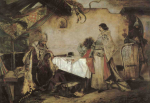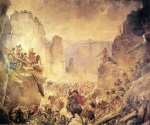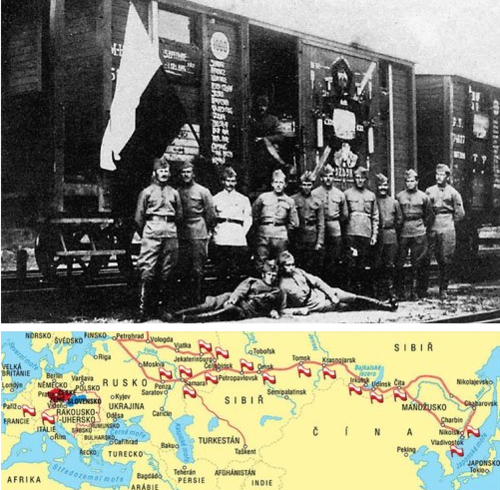In this video you will see Karel Gott singing about how he’ll cope with approaching breakup. There will be no head bowing neither he will lose his head. He plans to sweeten his coffee a little bit more, mentally caress his beloved (but nothing else!), celebrate Christmas alone, count his wrinkles in the spring and then figuratively move a house further ahead.
Month: July 2014
Václav Neckář and Helena Vondráčková: “Znám jednu starou zahradu” (from Czech fairy-tale film “Šíleně smutná princezna”). Music by Jan Hammer
after long time, next of mine fairy-tale illustrastions- here´s Měsíčník from my favorite czech fairy-tale 🙂 (he´s king of the Moon but he went down to marry young princess :3 )

Mikoláš Aleš (1852 – 1913) was a Czech painter, decorator and illustrator. Aleš is estimated to have had over 5,000 published pictures; he painted for everything from magazines to playing cards to textbooks and buildings. His paintings were not publicized too widely outside Bohemia, but Mikoláš Aleš is regarded as one of the Czech Republic’s greatest artists and a classic of the 19th century. Many of his paintings depict events or people from Czech history.
(1) After the battle near Ústí (2) Prokop Holý and Jan of Rokycany (3) Hussite cavalry (4) Mathias Corvinus and George of Poděbrady (5) Jan Roháč from Dubá (6) Slaugther of Saxons under Hrubá Rock + more here
SLAVIC TIME: HELL
Belarusian: пекла (piekla)
Bosnian: pakao
Croatian: pakao
Czech: peklo
Macedonian: пеколот (pekolot)
Polish: piekło
Serbian: пакао (pakao)
Slovak: peklo
Slovenian: pekel
Ukrainian: пекло (peklo)
Bulgarian: … ummm….
Russian: *sweats*
Rest of family: *eyes you two so hard it could fry an egg*
Bulgarian: Well. Aд (ad)?
Russian: Aд (ad).
Polish: … My poor sinners, welcome to hell. We have cookies OUO
Quick Czech history: the First World War
Previously: Political development until WW1
When the war stared, Czech soldiers were enlisted in the Austrian army without much enthusiasm. They were often treated as potential traitors, surrounded by rumours that they are put to the most dangerous places. No wonder that many soldiers ran over to the Serbs and Russians, taking the risk that if caught, they will be executed for desertion.
Still the majority of Czech soldiers fought for the Emperor and Austria, only about 10 % of all Czech soldiers joined Czechoslovak Legions fighting alongside Austria’s enemies.

Czech soldiers certainly didn’t have it easy. Including common war horrors and persecution, they also had to fight against their own people (where Austrian troops and Legions met) or nations to which they felt close to.
A teacher, politician, statesman and philosopher Tomáš Garrigue Masaryk. Second: Milan Rastislav Štefánik, the French army general, politician and also astronomer.
Resistance abroad
Masaryk already in 1915 presented his idea of Czechoslovakism in Switzerland, insisting on creating independent state for Czechs and Slovaks, predicting the collapse of Austria-Hungary. Every state needs an army – Masaryk realized that there are many Czech soldiers that don’t belong to Austrian army any more and fight for the Russians, Italians or Serbians. During this time also comes on scene Slovak Milan R. Štefánik, a general in French army who had many prominent foreign acquaintances that helped to create Czechoslovak legions = units of Czech and Slovak prisoners from Austrian army and compatriots living abroad that would fight for the creation of Czechoslovakia.
Masaryk and Štefánik along with Eduard Beneš also formed the Czechoslovak National Council (ČNR). Their goals were:
- unify the resistance
- break away from Austria-Hungary
- create the Czechoslovak state
The route of Czechoslovak Legions in Russia
Czechoslovak Legions drew attention to themselves both in Russia (Battle of Zborov) where they were largest and in Italy (Battle of Doss Alto). After the Bolshevik revolution were Legions declared as part of the French army (so that our soldiers weren’t extradited back to Austria-Hungary, where they were punished for treason) and ČNR was trying to move them quickly through Vladivostok to France. This wasn’t easy, because they had to fight over Germans to even get through Ukraine and after arriving to Chelyabinks, they’ve got themselves in conflict with the Bolsheviks. Soon they occupied the 8000 km long Trans-Siberian highway and thus controlled the whole Siberia. This created a global sensation.
Under this impression the U.S., France and Great Britain recognized the Czechoslovak National Council as the future government and finally agreed on the idea of a breaking Austria-Hungary. Czechs and Slovaks then became their official allies.Resistance at home
Organising resistance at home was very difficult. During them war Empire changed into military dictatorship and Czech national life was suppressed and heavily persecuted. C
Charles I of Austria was our last Hapsburg monarch. He decided to change Austrian policy and gave amnesty to several prisoners, while also thinking about the federalization of monarchy. But it was too late…
In October 14, 1918 started general strike against against exportation of food from Bohemia. People at the time expected Austria to fall at any moment and when28th October 1918 Austria requested ceasefire, it led to spontaneous demonstrations in Prague and claiming the Czechoslovak independence.
Two days later the Slovak National Council adopted the Martin Declaration of the Slovak nation, dropped connections with Hungary and applied to the common state of Czechs and Slovaks.
People in Prague celebrating creation of Czechoslovakia on Wenceslas Square

















